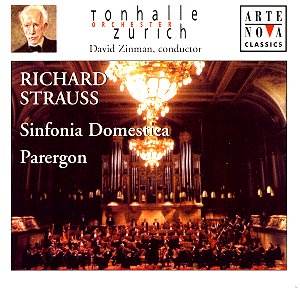Strauss
was not averse to making himself the subject of his own works,
for example as a hero in Ein Heldenleben, a lover in Intermezzo
and a father figure in Sinfonia Domestica, which he
dedicated to his ‘dear wife and children’. That he pursued this
lavish self-promotion through thrilling melodies and brilliant
orchestration does not alter the fact that the ‘plot’ is not particularly
interesting; so why not relax and let this voluptuous music wash
over you? This could be a reasonable alternative to trying to
sort out the domestic squabbles, splendours and miseries of the
Strauss family while listening. Papa might occasionally sound
like a self-obsessed old windbag, but he’s never boring.
It
seems almost as though both these works were allowed to evolve
in an improvisatory way; yet Strauss’s mastery of form and dramatic
incident is evident throughout. Nothing happens by chance, and
through all five movements of the Sinfonia the rich fabric
is embroidered with colourful threads and thrilling highlights.
As in Ein Heldenleben, there are quotations, and near-quotations,
from other Strauss works; yet, though Sinfonia Domestica
might appear an obvious example of programme music, it possesses
relatively few of the deft programmatic touches that make Til
Eulenspiegel and Don Juan masterpieces of musical scene
painting.
Zinman’s
approach is refreshing, highlighting the invention and vivacity
that pervades this unusual work. The well-upholstered sound that
has long characterised Strauss performances by most of today’s
European orchestras is replaced by a clean, clear interpretation
with a by no means leisurely beat that neatly evades pomposity.
Strauss
added a further ‘chapter’ to his story in Parergon, written
a year later for piano (left hand) and dedicated to the pianist
Paul Wittgenstein (1887-1961) who had lost his right arm in the
war of 1914-18. It contains five interconnected sections, and
is described in the insert booklet as ‘a symphonic virtuoso piano.piece’.
Parergon has been said to reflect Strauss’s undefined anxieties
about his own son. Once again these subjective allusions need
not unduly bother the listener. The work is markedly different
in scale and size from the Sinfonia, tonal and academic
in character, it does not lack interest and its inclusion on this
disc is justified, if only on the grounds of completeness. But,
though excellently performed, in my view it does not make a satisfactory
link to the Sinfonia and it is easier to regard it as a
separate work.
Roy
Brewer
